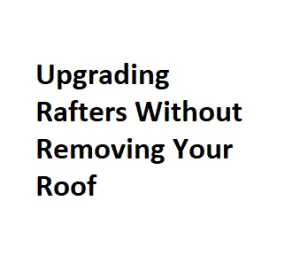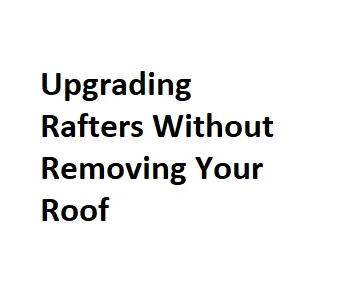The prospect of replacing rafters often conjures images of major construction projects involving the removal of an entire roof. However, advancements in construction techniques have made it possible to replace rafters without the daunting task of dismantling the roof structure. In this blog post, we’ll explore a user-friendly guide on how to upgrade your rafters seamlessly while keeping your roof intact.
Step 1: Assessing the Situation
Begin by thoroughly inspecting the condition of your rafters. Identify any damaged or weakened sections that require replacement. Take note of the specific areas that need attention to ensure a targeted and efficient replacement process.
Step 2: Gathering Materials and Tools
Before you start the replacement process, gather all the necessary materials and tools. This typically includes replacement rafters, fasteners, a saw, safety equipment, and any additional support structures you might need. Having everything on hand will streamline the process and reduce the likelihood of delays.
Step 3: Temporary Roof Support
To ensure the stability of your roof during the replacement, provide temporary support. Adjustable support jacks or sturdy props can be strategically placed to bear the weight of the roof while you work on the rafters below. This precautionary step is crucial to prevent any unintended structural issues.
Step 4: Partially Remove Roofing Materials
Carefully remove only the roofing materials directly above the damaged rafters. This may involve lifting shingles, tiles, or other roofing components to expose the targeted area. Take care not to damage these materials, as they will need to be reinstalled later.
Step 5: Exposing the Rafters
Once the roofing materials are lifted, clear away any debris or insulation to reveal the damaged rafters. This creates a clean workspace and allows for easy access to the sections in need of replacement.
Step 6: Precise Rafter Removal
Using a saw or a suitable cutting tool, precisely remove the damaged sections of the rafters. Take accurate measurements to ensure a seamless fit for the replacement rafters. Removing the damaged sections with precision is crucial to maintaining the integrity of the surrounding structure.
Step 7: Introducing Replacement Rafters
Carefully position the replacement rafters, ensuring they fit snugly into place. Secure the new rafters to the existing structure using appropriate fasteners like screws or nails. Double-check the alignment to guarantee a precise fit.
Step 8: Reinforce and Stabilize
Enhance the stability of the replaced rafters by reinforcing the connections. Braces, straps, or other supportive structures can be employed to ensure the newly installed rafters provide robust support for the roof.
Step 9: Reinstalling Roofing Materials
With the replacement rafters securely in place, meticulously reinstall the roofing materials that were temporarily removed. Pay attention to proper alignment and sealing to maintain the structural integrity of the roof.
Step 10: Final Checks and Inspections
Before considering the job complete, conduct a thorough inspection of the replaced rafters and the surrounding structure. Check for any signs of misalignment, instability, or issues with the fasteners. Address any discrepancies promptly to ensure the longevity and reliability of the new rafters.
Step 11: Consult with Professionals
While the steps provided offer a comprehensive guide for a DIY approach, it’s always a good idea to consult with professionals if you encounter challenges or if the damage to your rafters is extensive. Contractors or structural engineers can provide valuable insights and ensure that the replacement process aligns with building codes and safety standards.
Step 12: Document and Maintain Records
Keep detailed records of the replacement process, including photographs, measurements, and any modifications made. This documentation can be valuable for future reference, especially if you plan on selling your property or need to provide information to future contractors.
Step 13: Monitor Over Time
After the replacement, it’s essential to monitor the performance of the new rafters over time. Keep an eye on any changes in the roof structure, such as sagging or shifting. Regular monitoring allows you to catch potential issues early on and address them before they escalate.
Step 14: Weatherproofing and Sealing
Ensure that the replaced rafters are adequately weatherproofed and sealed. This step is crucial for preventing water intrusion, which can lead to rot and compromise the structural integrity of the rafters. Use appropriate sealants and weatherproofing materials to protect your investment and extend the lifespan of the replacement rafters.
Step 15: Consider Energy-Efficient Upgrades
While you have access to the roof structure, consider incorporating energy-efficient upgrades. This could include adding insulation to improve energy efficiency or installing solar panels for sustainable energy generation. Taking advantage of this opportunity can enhance the overall performance and eco-friendliness of your home.
Step 16: Share Your Experience
If you’ve successfully replaced rafters without removing the roof, consider sharing your experience with others. Document your journey through blog posts, social media, or community forums. Your insights and lessons learned can be valuable to homeowners facing similar challenges, creating a supportive online community.
Step 17: Routine Roof Maintenance
After the rafter replacement project is complete, commit to regular roof maintenance. Periodic inspections, gutter cleaning, and minor repairs can help prevent future issues and extend the lifespan of your roof. Maintaining a proactive approach to roof care will save you money in the long run and ensure the continued well-being of your home.
Benefits of Replacing Rafters Without Removing the Roof:
- Cost-Effective: This method can be more cost-effective than a full roof replacement, saving you money on labor and materials.
- Time-Efficient: By avoiding the need to remove and reinstall an entire roof, the process is generally quicker, minimizing disruptions to your daily life.
- Preservation of Existing Materials: Replacing rafters without removing the roof allows you to preserve existing roofing materials, such as shingles or tiles, reducing waste and associated costs.
- Minimized Structural Impact: The targeted approach minimizes the impact on the overall structure of your home, making it a more sustainable and eco-friendly option.
Rafter Material Options
| Material |
Strength (PSI) |
Weight (lbs/ft³) |
Cost ($/ft²) |
Installation Difficulty |
| Engineered Wood |
2000-3000 |
30-45 |
2.5-3.5 |
Moderate |
| Steel |
50,000-70,000 |
490-540 |
4.0-5.0 |
Moderate |
| LVL (Laminated Veneer Lumber) |
4500-6000 |
35-40 |
3.0-4.0 |
Moderate |
| Aluminum |
18,000-24,000 |
168-180 |
3.5-4.5 |
Easy |
| Solid Wood |
1200-1500 |
25-40 |
2.0-3.0 |
Difficult |
Rafter Reinforcement Methods
| Method |
Description |
Pros |
Cons |
Cost ($) |
| Sistering with Steel Beams |
Adding steel beams alongside existing rafters for extra support. |
Increased strength |
Requires professional installation |
10,000-15,000 |
| Plywood Gusset Plates |
Attaching plywood gussets to the sides of rafters to enhance their load-bearing capacity. |
Relatively cost-effective |
May require temporary roof support |
2,000-4,000 |
| Carbon Fiber Wrapping |
Applying carbon fiber strips around existing rafters to improve strength. |
Lightweight and non-intrusive |
Professional installation recommended |
5,000-8,000 |
| Epoxy Resin Injection |
Injecting epoxy resin into existing rafters to strengthen and stabilize them. |
Minimally invasive |
Effectiveness may vary |
3,500-6,000 |
| Rafter Bracing Systems |
Installing specialized bracing systems to provide additional support to the roof structure. |
Improved lateral stability |
Requires expert assessment and planning |
7,000-10,000 |
Safety Considerations
| Safety Measure |
Description |
| Temporary Roof Support |
Erecting temporary supports to ensure the roof remains stable during the rafter upgrade. |
| Personal Protective Equipment |
Ensuring workers wear appropriate safety gear, including helmets, gloves, and safety harnesses. |
| Professional Inspection |
Having a structural engineer assess the existing roof and proposed upgrades for safety compliance. |
| Fall Protection Systems |
Installing guardrails or safety nets to prevent falls during the rafter upgrade process. |
| Emergency Evacuation Plan |
Developing and communicating a plan for quickly evacuating the worksite in case of emergencies. |
Tools Required
| Tool |
Description |
| Circular Saw |
For cutting and shaping rafters and reinforcement materials. |
| Power Drill |
Essential for securing bolts, screws, and other fasteners. |
| Level |
Ensures the new rafters are aligned correctly. |
| Chalk Line |
Helps mark guidelines on the roof for precise installations. |
| Safety Harness |
Provides fall protection for workers operating at heights. |
Maintenance Tips
| Tip |
Description |
| Regular Inspection |
Periodically check the upgraded rafters and the overall roof structure for signs of wear or damage. |
| Clearing Debris |
Keep the roof free of debris, such as leaves or branches, to prevent additional weight and stress on the rafters. |
| Addressing Water Damage |
Promptly repair any water damage to prevent the weakening of the rafters over time. |
| UV Protection |
Apply UV-resistant coatings to protect the rafters from the sun’s harmful rays, prolonging their lifespan. |
| Professional Maintenance Checks |
Schedule regular inspections by professionals to identify and address any potential issues early on. |
Conclusion:
In the evolving landscape of home improvement, the ability to replace rafters without removing the roof is a game-changer. It not only offers a practical solution to structural issues but opens the door to a range of possibilities for enhancing your home’s efficiency and sustainability. By following these additional steps, you can go beyond mere replacement and turn a necessary project into an opportunity for improvement and innovation. Embrace the journey of home maintenance and improvement with a forward-thinking mindset, and your home will benefit for years to come.


